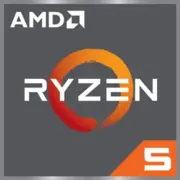AMD Ryzen 5 7520U

AMD Ryzen 5 7520U: Budget Processor for Everyday Tasks and Ultraportable Laptops
(Relevant as of March 2025)
Architecture and Manufacturing Process: Zen 2 on 6 nm with Modest Graphics
The AMD Ryzen 5 7520U processor, released under the codename Mendocino, is positioned as an energy-efficient solution for budget laptops. It is built on TSMC's 6nm FinFET—an optimized version of the 7nm manufacturing process—which helps reduce power consumption without sacrificing performance.
CPU Configuration:
- 4 cores and 8 threads thanks to SMT (Simultaneous Multithreading) technology.
- Base clock speed is 2.8 GHz, with a maximum turbo frequency of 4.3 GHz.
- L3 Cache — 4 MB, which is less than on higher-end Ryzen models (for example, the Ryzen 5 7640U has 16 MB).
- Integrated Radeon 610M graphics based on the RDNA 2 architecture, but with reduced specifications: just 2 compute units (128 stream processors) and a frequency up to 1.9 GHz.
The Zen 2 architecture used in this processor is not new—it debuted in 2019. However, it is sufficient for basic tasks, and the 6nm process helps reduce heat.
Power Consumption and TDP: 15 W for Thin Laptops
The processor's TDP is 15 W, which is typical for ultrabooks. This means:
- Laptops equipped with the Ryzen 5 7520U do not require a massive cooling system—a compact cooler or even passive heat dissipation in the thinnest models is sufficient.
- The processor is adapted for "Modern Standby," which is important for devices with touch screens and instant wake-up capabilities.
Power-saving technologies:
- Precision Boost 2 — automatic core overclocking depending on workload and temperature.
- AMD PowerNow! — dynamic adjustment of frequency and voltage.
Performance: Modest, but Stable
Testing results (Geekbench 6):
- Single-Core: 1183 — comparable to Intel Core i5-1135G7 (Tiger Lake).
- Multi-Core: 3739 — slightly below Ryzen 5 5500U (6 cores, Zen 2).
Real-world scenarios:
- Office work: Chrome with 20 tabs open, Word, Excel, Zoom — the processor handles tasks without delays.
- Multimedia: Streaming 4K video, basic editing in DaVinci Resolve (videos up to 1080p).
- Gaming: Only light titles — CS:GO (60 FPS on low settings), Dota 2 (40-50 FPS), Among Us. The Radeon 610M graphics are weaker than the Radeon 680M (12 cores) and comparable to Intel Iris Xe in Core i3.
Turbo Mode: Under brief loads (e.g., opening a "heavy" website), the clock speed rises to 4.3 GHz, but under sustained workloads (rendering a 10-minute video), it stabilizes at 3.1–3.4 GHz due to TDP limitations.
Usage Scenarios: Who is the Ryzen 5 7520U Designed For?
This processor is suitable for:
- Students — for studying, document work, and Zoom meetings.
- Office workers — as an alternative to Intel Core i3.
- Users who value battery life — for example, during travel.
- Owners of budget 2-in-1 devices — tablets with keyboards.
Not suitable for:
- Gamers (other than casual gaming).
- Engineers working with CAD or 3D modeling.
- Video editors processing 4K material.
Battery Life: Up to 10 Hours of Operation
Laptops with the Ryzen 5 7520U typically come with 40–50 Wh batteries. In mixed usage (web browsing, video, documents), the operating time is 8–10 hours.
What helps save battery charge:
- Adaptive frequency scaling: when typing, the processor reduces frequency to 1.2 GHz.
- Support for LPDDR5-5500 RAM — lower energy consumption when working with memory.
Comparison with Competitors
1. AMD Ryzen 3 7420U (Zen 2, 4 cores/8 threads) — 10-15% weaker in multi-threaded tasks.
2. Intel Core i5-1335U (10 cores, 12 threads) — better in single-threaded tests (Geekbench 6 SC ~1400), but more expensive.
3. Apple M1 (8 cores) — surpasses the Ryzen 5 7520U in energy efficiency and performance, but laptops with M1 start at $900.
Price Range: Laptops with the Ryzen 5 7520U are priced at $450–700. For example:
- Lenovo IdeaPad 5 15″ (16 GB RAM, 512 GB SSD) — $599.
- HP Pavilion Aero 13 (13.3″, 1 kg) — $649.
Pros and Cons
Strengths:
- Low price of laptops.
- Sufficient performance for everyday tasks.
- Good battery life.
Weaknesses:
- Outdated Zen 2 architecture.
- Weak graphics performance.
- Limited L3 cache (4 MB).
Laptop Selection Recommendations
1. Type of device: Ultrabooks (Acer Swift 3, ASUS Vivobook) or compact 2-in-1s (Lenovo Flex 5).
2. Display: IPS matrix with Full HD resolution — for comfortable work.
3. RAM: 16 GB LPDDR5 — for multitasking.
4. Storage: SSD (512 GB and above) is a must.
What not to overpay for:
- Discrete graphics — the Radeon 610M won't be a substitute.
- 4K touch screen — the processor cannot handle resource-intensive tasks.
Final Conclusion
AMD Ryzen 5 7520U is a solid choice for those looking for an inexpensive laptop for work, study, or travel. Its key advantages are:
- Energy efficiency and long battery life.
- Stable performance in office applications.
- Affordable price.
However, this is not a universal solution. If you need a mobile workstation or gaming laptop, consider models with the Ryzen 7 7840U or Intel Core Ultra 5.
Prices and models are accurate as of March 2025. Please verify the specifications of specific devices before purchasing.
Basic
CPU Specifications
Memory Specifications
GPU Specifications
Miscellaneous
Benchmarks
Compared to Other CPU
Share in social media
Or Link To Us
<a href="https://cputronic.com/en/cpu/amd-ryzen-5-7520u" target="_blank">AMD Ryzen 5 7520U</a>